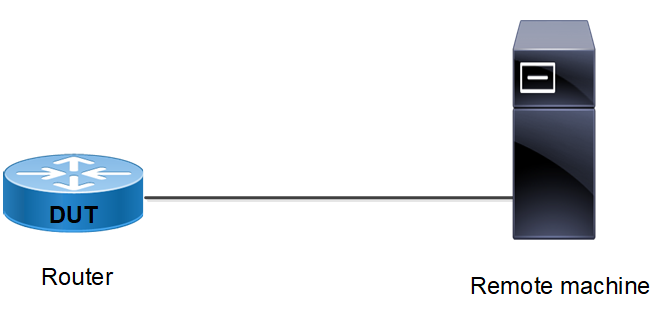Telnet Configuration
Overview
Telnet is a TCP/IP protocol used on the Internet and local area networks to provide a bidirectional interactive text- oriented communications facility using a virtual terminal connection. The Telnet program runs, connects it to a server on the network. A user can then enter commands through the Telnet program and they will be executed as if the user were entering them directly on the server console.Telnet enables users to control the server and communicate with other servers on the network. The default port number for Telnet protocol is 23.Telnet offers users the capability of running programs remotely and facilitates remote administration.
In-band Management Over Default VRF
OcNOS supports Telnet over the default and management VRFs via in-band management interface and OOB management interface, respectively.
By default, Telnet runs on the management VRF.
Topology

Telnet topology
Enable and Disable the Telnet Server
#configure terminal | Enter configure mode |
(config)#no feature telnet vrf management | Disable Telnet feature |
(config)#feature telnet vrf management | Enable Telnet feature |
(config)#exit | Exit configure mode |
Configure the Telnet Server Port
#configure terminal | Enter configure mode |
(config)#no feature telnet vrf management | Disable Telnet feature |
(config)#telnet server port 6112 vrf management | Set Telnet port to 61112 |
(config)#feature telnet vrf management | Enable Telnet feature |
(config)#exit | Exit configure mode |
Telnet Client Session
#telnet 10.10.10.1 vrf management | Log into remote machine using IPv4 address |
Validation Commands
#show telnet server
telnet server enabled port: 6112
#show running-config telnet server
feature telnet
In-band Management for User Defined VRF
From release 6.5.3, OcNOS supports Telnet over the user defined vrfs as well along with default and management VRFs via in-band interface.
By default, Telnet runs on the management VRF. If user wants to enable telnet feature over user defined vrfs which can be part of MPLS L3VPN/EVPN, it is possible to enable telnet feature over those user defined vrfs.
User must able to enable telnet feature over multiple user defined vrfs simultaneously with default/non default telnet ports.
Telnet Configuration with IPv4 Address for User Defined VRF
Topology

Telnet Configuration topology
Enable and Disable the Telnet Server on user defined vrf say vrf name is vrf_test
#configure terminal | Enter configure mode |
(config)#no feature telnet vrf vrf_test | Disable Telnet feature |
(config)#feature telnet vrf vrf_test | Enable Telnet feature |
(config)#commit | Commit the candidate configuration to the running configuration |
(config)#exit | Exit configure mode |
Configure the Telnet Server Port on user defined vrf say vrf name is vrf_test
#configure terminal | Enter configure mode |
(config)#ip vrf vrf_test | Configure User defined vrf |
(config)#no feature telnet vrf vrf_test | Disable Telnet feature |
(config)#telnet server port 6112 vrf vrf_test | Set Telnet port to 61112 |
(config)#feature telnet vrf vrf_test | Enable Telnet feature |
(config)#commit | Commit the candidate configuration to the running configuration |
(config)#exit | Exit configure mode |
Telnet Client Session
#telnet 10.10.10.1 | Log into remote machine using IPv4 address |
Validation
#show telnet server
VRF MANAGEMENT
telnet server enabled port: 23 VRF DEFAULT:
telnet server enabled port: 23
VRF vrf_test:
telnet server enabled port: 6112
#show running-config telnet server
feature telnet vrf vrf_test
feature telnet vrf management
feature telnet